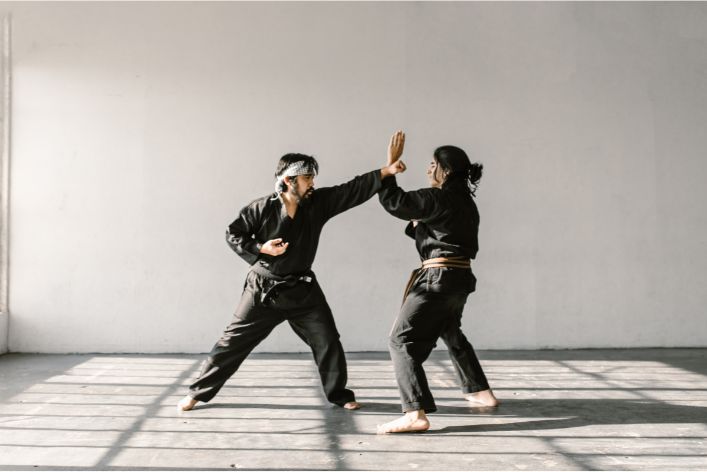Martial arts have grown in popularity due to their physical and mental benefits. Taekwondo is a Korean martial art that focuses on kicks, while other martial arts like karate and jiu-jitsu emphasize hand-to-hand combat. This blog post aims to highlight the key differences between Taekwondo and other popular martial arts.

By the end of this blog post, readers should have a clear understanding of what sets Taekwondo apart from other martial arts and which one might be the best fit for them. So, if you are curious about which martial art is right for you, keep reading!
Origins of Taekwondo and Other Martial Arts
Martial arts span centuries of human history, originating from diverse global regions. Let’s explore Taekwondo, Karate, Judo, and Kung Fu origins
History of Taekwondo
- Taekwondo originated in Korea and was developed during the 1940s and 1950s.
- The martial art was heavily influenced by traditional Korean martial arts, such as Taekkyon and Subak.
- The name “Taekwondo” was officially adopted in 1955.
- Taekwondo became an Olympic sport in the 2000 Sydney Olympics.
History of Other Popular Martial Arts (Karate, Judo, Kung Fu, etc.)
- Karate originated in Japan and was developed from indigenous fighting methods and Chinese martial arts.
- Judo originated in Japan and was founded by Jigoro Kano in 1882. It is based on techniques from various traditional Japanese martial arts.
- Kung Fu originated in China and has a long history that dates back to ancient times. It includes a wide variety of styles and techniques.
- Muay Thai originated in Thailand and is also known as the “art of eight limbs” as it uses kicks, punches, elbow strikes, and knee strikes.
Differences in Origins and Cultural Influences
The origins and cultural influences of martial arts have a significant impact on their techniques and training methods. Taekwondo, for instance, is deeply rooted in Korean culture and emphasizes speed and agility. Meanwhile, Karate emphasizes strong, powerful strikes and is heavily influenced by Japanese culture.
Judo focuses on throwing and grappling techniques and is based on the principles of balance and harmony. Kung Fu is a diverse martial art that encompasses a wide range of styles and techniques, and its origins can be traced back to Chinese culture and philosophy.
In fact, while all martial arts share some fundamental principles, such as discipline and respect, their origins and cultural influences have shaped them in unique ways. It’s important to understand these differences when choosing a martial art to pursue, as they can greatly affect your training experience and goals.
Read: Choosing the Right Taekwondo School for You
Training and Techniques
Taekwondo Training Methods
Taekwondo is a Korean martial art that focuses on using kicks and punches to defend oneself. The training methods used in Taekwondo are geared towards achieving flexibility, strength, and speed. Taekwondo training begins with mastering basic stances, kicks, and punches, and then progressing towards more advanced techniques.
Techniques in Taekwondo
In Taekwondo, the techniques used primarily involve kicks and punches. These techniques require a great deal of balance, speed, and precision. Some of the most commonly used techniques in Taekwondo include front kicks, side kicks, back kicks, roundhouse kicks, and jump kicks. The key to mastering these techniques is through constant practice and repetition.
Comparison with Other Martial Arts
Taekwondo differs significantly from other martial arts primarily due to its focus on kicks. Other martial arts, such as Karate or Jiu-Jitsu, focus more on hand strikes and grappling. Taekwondo is also unique in its emphasis on flashy moves and acrobatics. Unlike other martial arts, Taekwondo also places a great deal of importance on flexibility and mobility.
Key Differences in Training and Techniques between Taekwondo and Other Martial Arts
One of the key differences in training between Taekwondo and other martial arts is the emphasis placed on physical conditioning. Taekwondo practitioners focus heavily on building strength, flexibility, and endurance. Additionally, Taekwondo training is centered around developing speed, which is critical to delivering powerful kicks.
Technique-wise, Taekwondo is markedly different from other martial arts. The use of kicks is one of the most significant differences between Taekwondo and other martial arts. Unlike Karate, Taekwondo emphasizes using kicks as the primary method of attack, while Karate focuses on using hand strikes. Another difference between Taekwondo and other martial arts is the emphasis placed on acrobatics. Taekwondo practitioners often learn moves such as spinning kicks and jumping kicks, which are not typically incorporated into other martial arts.
The training methods and techniques used in Taekwondo are unique in comparison to other martial arts. The focus on kicks, physical conditioning, and speed make it a dynamic and challenging martial art. As with all martial arts, the key to becoming a proficient Taekwondo practitioner is through dedication and discipline in training.
Read: The Mental and Physical Benefits of Taekwondo
Rules and Competitions
Taekwondo, just like many other martial arts, has a set of rules and regulations that govern its competitions. However, Taekwondo has some unique features that set it apart from other martial arts in terms of competitions. Below are some key differences that distinguish Taekwondo competitions from other martial arts competitions:
Innovative Tech Solutions, Tailored for You
Our leading tech firm crafts custom software, web & mobile apps, designed with your unique needs in mind. Elevate your business with cutting-edge solutions no one else can offer.
Start NowTaekwondo as an Olympic sport
One of the most significant differences between Taekwondo competitions and other martial arts competitions is that Taekwondo is an Olympic sport. This means that Taekwondo is subject to rules and regulations set by the International Olympic Committee (IOC).
The IOC scrutinizes and evaluates Taekwondo for its suitability as an Olympic sport. This global platform gives Taekwondo an advantage over other martial arts.
Comparison between Taekwondo competitions and other martial arts competitions
Taekwondo competitions incorporate a variety of techniques that are geared towards striking an opponent with one’s foot or fists. In contrast, some martial arts such as Judo and Brazilian Jiu-Jitsu rely on grappling techniques, throws, and submission holds.
A Taekwondo bout usually lasts for three rounds of two minutes each, while other martial arts may have different time limits. Furthermore, the criteria used to determine a winner in Taekwondo are different from those used in other martial arts.
In Taekwondo, players score points by landing kicks and punches on the opponent’s torso and head. Other martial arts such as Judo and Karate place more emphasis on takedowns, throws, and choking techniques.
Differences in Rules and Scoring Systems
The rules and scoring systems used in Taekwondo competitions differ significantly from those used in other martial arts competitions. Taekwondo competitions have an electronic scoring system that registers points when a player lands a kick or punch to the opponent’s torso or head.
Some martial arts such as Judo and Greco-Roman wrestling use a system that awards points based on how long a player pins their opponent to the mat. Similarly, Brazilian Jiu-Jitsu awards points for takedowns, sweeps, and submission holds.
Taekwondo competitions also allow players to wear protective gear, which is not the case in some martial arts where players only wear traditional attire.
While all martial arts have common features, each has its unique set of rules and regulations that govern its competitions. Taekwondo competitions stand out in terms of their suitability as an Olympic sport, the techniques used, the duration of each bout, the criteria for determining a winner, and the scoring system. The differences ensure that each martial art maintains its identity while offering something unique to its practitioners and spectators.
Read: How to Improve Your Taekwondo Techniques Fast

Philosophy and Beliefs
Taekwondo is a martial art that originated in Korea and has become popular worldwide due to its combination of self-defense techniques and mental discipline. One of its key focuses is on developing discipline and mental fortitude, rather than just physical ability. Let’s take a closer look at the philosophy and beliefs of Taekwondo and how they differ from other martial arts.
Taekwondo’s Focus on Discipline and Mental Development
- Taekwondo is not just about learning how to fight, but also about developing discipline and mental strength.
- Practitioners of Taekwondo are expected to adhere to a strict code of conduct, which emphasizes respect for oneself and others.
- This code of conduct is reinforced through the practice of various rituals and traditions, such as bowing to one’s instructor, fellow students, and the training grounds.
- In Taekwondo, students are taught to look inward and focus on developing their own character rather than competing against others.
- The ultimate goal of Taekwondo is not to become a great fighter, but rather to become a better person.
Comparison with Other Martial Arts’ Philosophies and Beliefs
- Many other martial arts, such as Karate, Judo, and Kung Fu, also place a strong emphasis on discipline and mental development.
- However, the specific philosophies and beliefs of these martial arts may differ from Taekwondo.
- Karate, for example, is focused on developing a strong spirit, and stresses the importance of humility and perseverance.
- Judo, on the other hand, emphasizes the principles of maximum efficiency and mutual welfare and benefit.
- Kung Fu, which encompasses a wide range of different styles, is rooted in the philosophy of Taoism and emphasizes the cultivation of inner strength and balance.
Differences in Values and Principles between Taekwondo and Other Martial Arts
- While all martial arts share some common values and principles, there are some key differences between Taekwondo and other martial arts.
- One of the biggest differences is the focus on kicking techniques in Taekwondo, whereas other martial arts may place more emphasis on punching, grappling, or throwing techniques.
- In addition, Taekwondo also places a strong emphasis on speed and agility, which may not be as important in other martial arts.
- Another key difference is the use of sparring as a training tool.
- While many martial arts use sparring to help students practice their techniques in a realistic setting, Taekwondo sparring is often more fast-paced and relies heavily on kicking techniques.
In essence, Taekwondo’s philosophy and beliefs are rooted in the development of discipline, mental strength, and personal character. While other martial arts also place a strong emphasis on these values, the specific philosophies and beliefs may differ. Additionally, Taekwondo’s focus on kicking techniques, speed, and agility, and its unique style of sparring set it apart from other martial arts.
Read: Understanding Taekwondo Belt System and Ranks
Practicality in Real-Life Situations
When it comes to self-defense situations in everyday life, the effectiveness and practicality of different martial arts can vary greatly. While Taekwondo and other martial arts share some similarities in their approaches, there are also key differences that can affect how practical they are in real-life situations.
Usefulness of Taekwondo and Other Martial Arts in Self-Defense Situations
Taekwondo, along with other martial arts like Karate and Jiu-Jitsu, is often promoted as an effective means of self-defense. However, the usefulness of any martial art in a self-defense situation ultimately comes down to the individual’s ability to apply its techniques effectively.
That being said, Taekwondo does have some techniques that are specifically geared towards self-defense situations, such as strikes to vulnerable areas like the eyes, throat, and groin. Additionally, the emphasis on agility and speed in Taekwondo can be an advantage in real-life situations where speed and quick reactions are essential.
Comparison of Effectiveness in Real-Life Situations
When comparing the effectiveness of Taekwondo to other martial arts in real-life situations, a number of factors come into play. For example, Brazilian Jiu-Jitsu and Krav Maga are often cited as highly effective martial arts for self-defense due to their focus on grappling and close-range combat. In contrast, Taekwondo’s focus on kicks and strikes from a distance may be less effective in close-range situations where grappling is necessary.
However, it is also important to note that the effectiveness of a martial art in a real-life situation is heavily dependent on the individual’s level of training and experience. A skilled Taekwondo practitioner may be able to effectively defend themselves against an untrained attacker, while a Krav Maga practitioner with little training may not be as effective in the same situation.
Read: The History and Origins of Taekwondo Explained
Differences in Approaches to Practicality in Taekwondo and Other Martial Arts
Taekwondo heavily emphasizes sparring during training to develop practical skills. It lets practitioners apply techniques in a controlled environment. Conversely, martial arts like Wing Chun prioritize partner drills and forms over sparring to develop technique. This approach may seem less practical for real-life scenarios, as it may not directly translate to situations encountered in daily life.
Taekwondo and other martial arts share self-defense similarities, but key differences exist. Effectiveness depends on individual technique application and experience. Choosing a martial art for practical purposes requires considering these factors and aligning with personal goals and abilities.
Read: Taekwondo for Beginners: How to Get Started
Conclusion
Taekwondo uniquely combines high-impact kicks, self-defense techniques, and discipline. Unlike other martial arts, it emphasizes leg techniques, ideal for enhancing kicking abilities.
Renowned for rigorous physical and mental training, Taekwondo suits those seeking overall fitness and discipline. However, every martial art doesn’t fit everyone. Different strengths, interests, and goals might make another martial art, like Brazilian Jiu-Jitsu or Muay Thai, more suitable.
Seamless API Connectivity for Next-Level Integration
Unlock limitless possibilities by connecting your systems with a custom API built to perform flawlessly. Stand apart with our solutions that others simply can’t offer.
Get StartedBrazilian Jiu-Jitsu, focusing on ground fighting and grappling, is an excellent choice for improving the ground game. On the other hand, Muay Thai, emphasizing striking and clinching techniques, suits those keen on mastering close-quarters combat.
Ultimately, the choice of martial art will depend on several factors, such as personal interests, goals, and physical abilities. However, as we have seen, Taekwondo is an excellent martial art that offers unique benefits and training methods that set it apart from other martial arts. If you are interested in trying out a martial art, Taekwondo is definitely worth considering.
Read: Jiu Jitsu vs. Other Martial Arts: What Sets It Apart?
Before You Go…
Hey, thank you for reading this blog to the end. I hope it was helpful. Let me tell you a little bit about Nicholas Idoko Technologies. We help businesses and companies build an online presence by developing web, mobile, desktop, and blockchain applications.
We also help aspiring software developers and programmers learn the skills they need to have a successful career. Take your first step to becoming a programming boss by joining our Learn To Code academy today!
Be sure to contact us if you need more information or have any questions! We are readily available.











